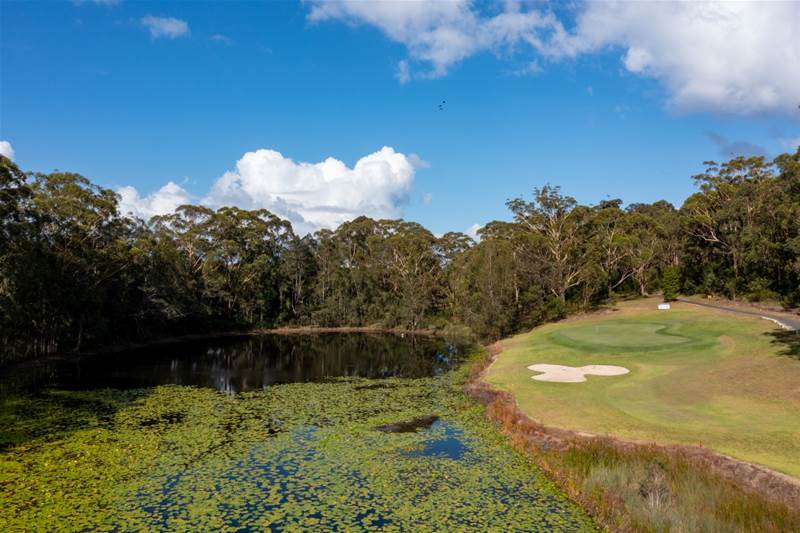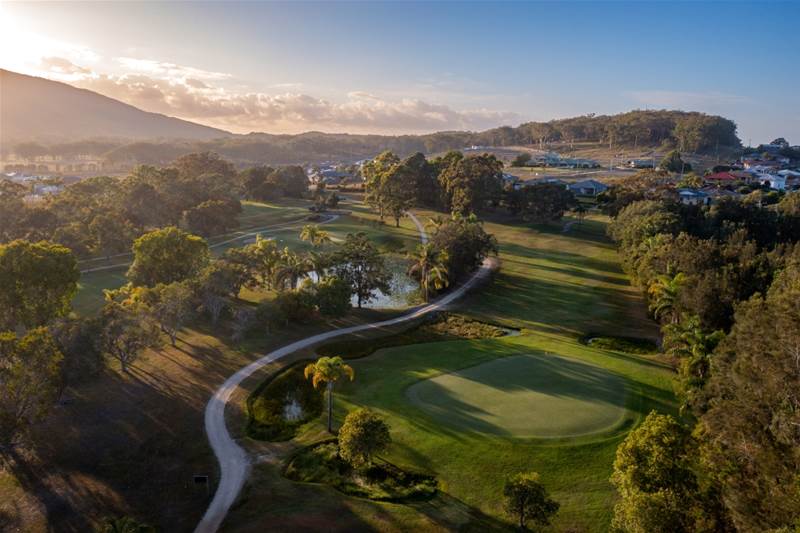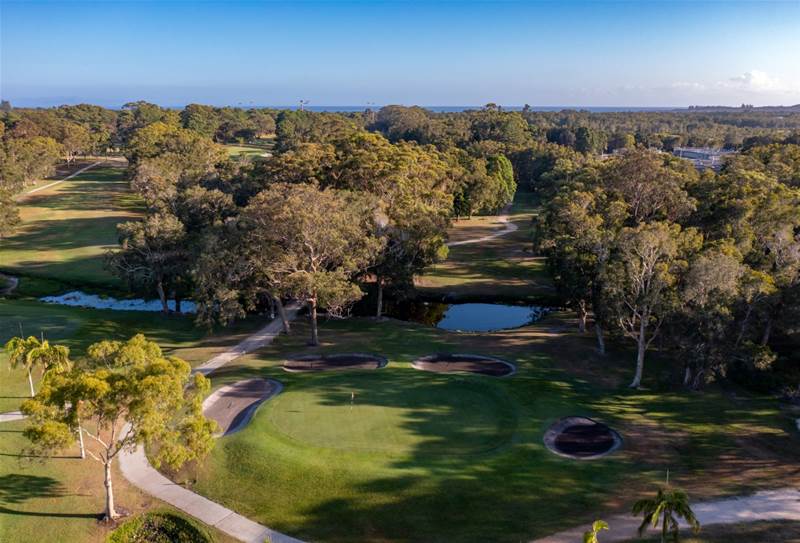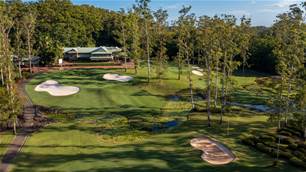There are just a handful of places along the length of Australia’s East Coast where the majestic Great Dividing Range comes close to meeting the edge of the Pacific Ocean. The Coffs Coast, almost halfway between Sydney and Brisbane via the Pacific Highway, is one of those places.
The course first opened for play in 1946 and over the years more holes were added to finally complete a par-71 18-hole course. The layout was completely redeveloped during the 1990s, as the club’s greens staff worked through a systematic rebuilding of all the putting surfaces. The old table-top greens were replaced with larger, more imaginative, putting surfaces featuring swales and tiers. They were grassed with Bermuda Tifgreen 328, which is more suitable for greens in warmer and wetter sub-tropical climates. The modernising of the greens also gave scope for improving greenside bunkering.
Today, Sawtell’s green complexes are among the best presented on the NSW North Coast.
After playing the downhill 1st hole, the par-4 2nd climbs the same hill back to the clubhouse. It plays considerably longer than its 279 metres and accuracy is needed to avoid the tall gum trees that cloak the tee and form a chute to the fairway. Club selection for the approach shot is important and can be two- to three-clubs more than what you may need for a flat lie shot. The green slopes steeply off the front, while the top plateau has a dish-like appearance, while the huge bunker left of the green is best avoided.
Chances are if you are travelling to the Coffs Coast for the first time you may not have heard of Safety Beach Golf Club.

Previously known as the Woolgoolga Diggers Golf Club, Safety Beach covers some pretty good golfing terrain on the northside of Woolgoolga, about 30 minutes’ drive north of Coffs Harbour.
A round on the heavily tree-lined par-72 layout is nearly always played with an accompanying breeze. But the wind and huge trees across the course are not the only factors influencing your scoring here with numerous water hazards, wetlands and bunkers coming into play across the 18 holes.
The course opens with two short par-4s that can yield back-to-back birdies as easy as consecutive bogeys depending on the quality of your tee shot. But it’s not until you have rounded the sharp dogleg left on the par-5 3rd hole that you get a real sense of the course that lies ahead. Faced with a long downhill approach, the green is quite reachable in two blows but it is actually better to finish short as a pond lies just beyond the putting surface.

Water is also comes into play greenside on the best, in my opinion, short par-4 at Safety Beach. The 283-metre 5th is tempting for big hitters standing on the tee, but I think I would back the conservative play to yield a birdie here. A water hazard stretches from the front of the tee all the way down the right edge of the fairway to flow into a lily-covered pond lying hard against the right fringe of the putting surface. Bets to lay-up short of a lone bunker in the middle of the fairway, about 40 metres short of the green, and leave a straightforward pitch into the narrow green.
There is more water to contend with on the back nine, with the tee shot on the 117-metre 11th hole being the most visually confronting. The tee shot needs to be played across a lake to an elevated green two-tiered, kidney-shaped green cut into the side of a hill. While the carry is not too daunting, it is the prospect that any shot missing the putting surface left could easily trickle down the hill into the drink.

If you plan to stay and play on the Coffs Coast for more than a few days, it is certainly worth making the 70-minute drive south for a round at the South West Rocks Country Club.
This layout is a terrific hidden gem. Most of the fairways are lined with stands of Norfolk pines and a few species of gum trees, while there are also a selection of wider, more open holes featuring palm trees.
A mix of kikuyu and couch cover the fairways, which are beautifully presented. But it is the quality of the bentgrass putting surfaces you will remember long after your round. Course superintendent David Hobday has certainly done a great job in getting the greens to a standard many city clubs would be envious of.
Complementing the superb playing surfaces are some really fun holes, with few better than the 383-metre par-4 15th, which also ranks as the hardest. It is a quality-driving hole where your tee shot flies slightly downhill to a narrow fairway lined with bushy gums. There really is no option but to take driver because your first shot must be as long as possible, to leave you a chance of hitting the green, lying just beyond a wide stream, in two shots. It is, however, an enormous target but its many dips and rolls make it imperative that you aim for the best putting position available. Any approach finishing long of the flag will offer a slick breaking downhill putt that will have your knees knocking.

South West Rocks also features some very good short par-4s with the sharp dogleg right 6th, known as Clarke’s Corner, offering a birdie chance as you turn back towards the clubhouse. The elevated tee offers a glimpse of the huge green that sits beyond a dam on the inside corner of the dogleg. What it doesn’t reveal is the series of smaller ponds that ring the putting surface like bunkers. At 255 metres, longer hitters will be tempted at trying to the drive the green but they had better be sure of their club selection and ability to hit the tee shot straight.
The best short two-shotter on the inward nine is the 304-metre 17th, known as Melaleuca. It shouldn’t come as any surprise that melaleucas, and pines, impinge on the straight-away fairway. A long-iron or fairway wood is the ideal club from the tee to leave a full wedge or short iron approach to the slightly elevated green guarded by two bunkers, one left and one right. The better player needs to be wary as the front half of the green slopes markedly down to the front fringe and is very receptive to spin.

TOURING THE COFFS COAST
With a winning combination of excellent accommodation, a bustling foodie scene and jaw-dropping natural beauty, it’s no wonder the Coffs Coast has long been a popular holiday destination.
The Coffs Coast is the only place in NSW where the Great Diving Range meets the ocean… home to a rich ecosystem including world-heritage National Parks, State Forests, Flora Reserves and the Solitary Islands Marine Park, the oldest of its kind in the state. The region also boasts sites of great significance to the traditional owners of this land, the Gumbaynggirr People.
In 2021 the Coffs Coast was globally recognised as an ECO Destination … celebrated for its diverse cultural community, committed to balancing sustainable practices with first-class, nature-based visitor experiences. It is NSW’s first ECO destination.

NATURE ESCAPES
Love the outdoors? Here are some great ideas for experiencing the natural wonders in and around Coffs Harbour.
• Stroll along the northern breakwall to Muttonbird Island, keeping an eye on the water to spot turtles and dolphins along the way. Then, take the steep walk over the island to the eastern lookout for unique views back over Coffs Harbour before visiting the island’s fascinating Gumbaynggirr outdoor learning centre.
• The Coffs Botanic Garden in the heart of the city is perfect for a picnic and relaxing walk. Set among 20 acres of lush plant life, you’ll find exotic and native species and glasshouses containing rare displays of tropical plants.
• No Coffs Coast holiday is complete without a visit to Forest Sky Pier and the award-winning Sealy Lookout, which stretches out from an escarpment 310 metres above Coffs Harbour and offers unparalleled coastal views of up to 100km to the south on a clear day.

• One of Coffs Harbour’s icons, The Jetty was built in 1890 from local timber to accommodate cargo vessels. Now it’s where locals congregate to fish, swim, stroll, watch the sunrise or dine on fish ‘n’ chips.
• Just five minutes from the city, Coffs Creek is an oasis for families who can safely paddle in its shallow turquoise waters. The creek and its mangrove forests can be easily accessed at several points, and are begging to be explored on a paddleboard or kayak.
FABULOUS FOOD & DRINK
The Coffs Coast packs a punch when it comes to foodie experiences. Whether it’s freshly caught seafood, fine wines, distilled spirits, craft beers or incredible coffee, there’s a foodie experience here to tickle your taste buds.

Immerse yourself in a full-day tour with the experts and learn about the stories behind our producers and the inspiration behind the flavours they create. Explore on your own and take your time relaxing with friends to discover the fabulous country hospitality while your taste buds experience the new and fresh unique regional flavours.
Find everything you need for a Coffs Coast getaway at www.coffscoast.com.au
WHERE TO PLAY
BONVILLE GOLF RESORT
Green fees: Golf is available for inhouse guests seven days and to general public guests on Mondays and Tuesdays (except public holidays). Public: $175 (18 holes, inc. cart, September to May); $170 (June to August).

COFFS HARBOUR GC
Green fee: $50 (18 holes).
www.coffsharbourgolfclub.com.au
BELLINGEN GC
Green fees: $20 (18 holes). $15 (unlimited golf after 2pm and all day Sunday).
SAWTELL GC
Green fee: $40 (18 holes).

NAMBUCCA HEADS ISLAND GC
Green fee: $40 (18 holes, pictured below)
SAFETY BEACH GC
Green fee: $19 (unlimited golf).
SOUTH WEST ROCKS CC
Green fee: $30 (18 holes).
Related Articles

Aussie golf stars praise Open's return to traditions
Heartbreak for Aussies at history-making Asia-Pacific Amateur

_Header.jpg&h=600&w=850&c=0&s=1)











